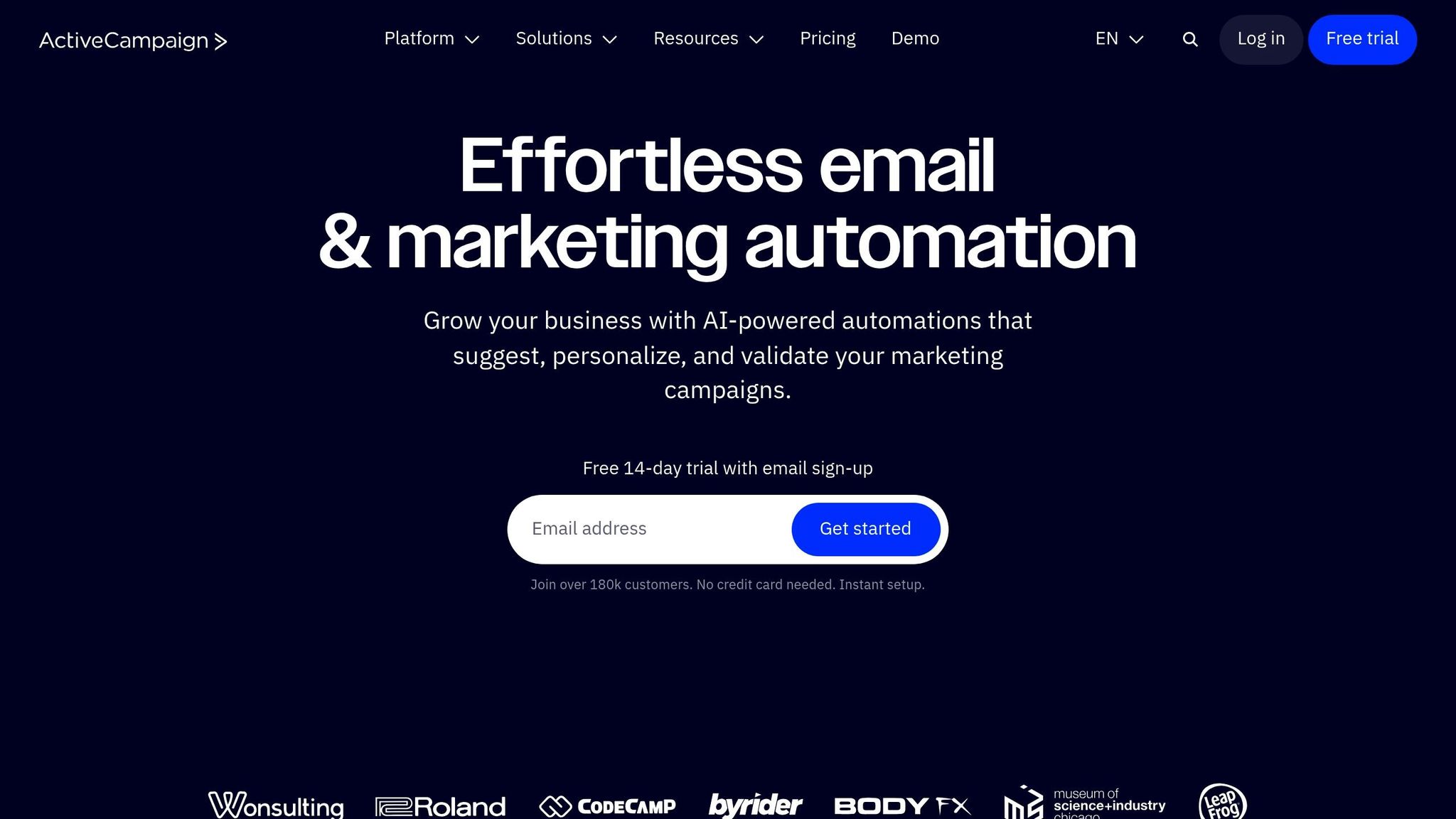Demographic segmentation automation helps businesses target the right audience by using data like age, location, income, and company size. Tools process massive data sets in real time to improve lead quality, create personalized campaigns, and boost sales conversions. Here's what you need to know:
- What It Does: Automatically gathers, enriches, and organizes data from sources like LinkedIn, company websites, and social profiles.
- Key Features:
- Adds detailed company data to lead profiles.
- Scores leads based on demographic fit.
- Launches targeted campaigns and automates follow-ups.
- Why It Matters: Saves time, ensures accuracy, and helps focus on high-value prospects.
- Example: Platforms like Hatrio Sales process over 1.5 billion profiles, helping over 104,000 websites achieve better sales results.
This technology transforms raw data into actionable insights, allowing businesses to connect with their ideal customers efficiently.
How to Use ActiveCampaign Segmentation Automation (Step ...

Understanding Demographic Segmentation
Demographic segmentation breaks the market into groups based on factors like age, income, and location. By analyzing these characteristics, businesses can develop focused sales strategies and better understand their target audience. This approach uses measurable variables to create detailed customer profiles.
Main Demographic Variables
Here are the primary demographic variables that shape effective segmentation:
| Variable | Description | Business Impact |
|---|---|---|
| Age | Generation groups and life stages | Shapes product preferences and buying behavior |
| Income | Purchasing power and economic status | Guides pricing strategies and product tiers |
| Education | Academic background and qualifications | Impacts communication style and product complexity |
| Occupation | Professional role and industry | Helps with B2B targeting and positioning |
| Location | Geographic presence | Optimizes regional campaigns |
| Company Size | Number of employees and revenue | Essential for B2B lead qualification |
By combining these variables, businesses can build precise customer profiles. For instance, you might target C-level executives at mid-sized companies in specific metro areas with annual revenues exceeding $10 million.
Why Use Demographic Segmentation
Demographic segmentation provides several key benefits for improving sales strategies:
-
Better Lead Quality
Focus on leads that closely align with your ideal customer profile. -
Stronger Campaign Results
Craft messages that resonate with specific groups, boosting engagement and conversions. -
Smarter Resource Allocation
Concentrate your efforts on high-value segments, maximizing ROI and minimizing wasted resources. -
Informed Decision-Making
Use real-time data insights to refine strategies and respond to market changes effectively.
Core Functions of Demographic Automation
Demographic segmentation automation uses advanced data processing tools to turn raw data into actionable sales insights. Here's a closer look at how data is collected, processed, and utilized.
Gathering and Combining Data
Automated systems pull in data from various sources to build detailed customer profiles. Key data points include:
| Data Type | Source Examples | Details Added |
|---|---|---|
| Professional Data | LinkedIn profiles, company sites | Job titles, work history |
| Company Information | Business databases, domain records | Industry, revenue, size |
| Contact Details | Email verifiers, social profiles | Verified emails, phone numbers |
| Geographic Data | IP addresses, registration forms | Location, time zone |
These data points are merged to create unified profiles. For example, the Hatrio Sales platform manages a database of over 1.5 billion data points, offering detailed demographic and firmographic enrichment for leads.
Automated Data Processing
Once collected, data is processed and organized using algorithms. Key steps include:
- Data Verification: Ensuring the information is accurate and up-to-date.
- Profile Completion: Filling in missing details automatically.
- Lead Scoring: Ranking prospects based on their demographic match and engagement level.
- Segment Categorization: Grouping leads into appropriate categories.
Real-Time Segmentation Workflow
This process runs continuously, ensuring customer segments are always current. Here's how it works:
- Data Collection The system gathers fresh data from sources like social media, company databases, and user interactions. Platforms like Hatrio Sales, which serve over 104,000 websites, can handle massive data streams in real time.
-
Automated Analysis
Algorithms analyze the data to identify patterns and update segments. This involves:
- Verifying and refreshing records and lead scores.
- Adjusting segment assignments dynamically.
-
Triggering Actions
Based on updated segments, the system can:
- Assign leads to the right sales teams.
- Launch targeted email campaigns.
- Update CRM systems with enriched profiles.
This streamlined process ensures sales teams have the most current and precise information to work with.
sbb-itb-b22f30c
Using Demographic Automation in Sales
Demographic automation transforms data into actionable sales strategies. Here’s how sales teams can make the most of this technology in their daily workflows.
Finding Better Leads
Demographic automation helps pinpoint high-value prospects by analyzing multiple data points at once. Here’s how it works:
| Lead Quality Factor | Automation Advantage | Impact on Sales |
|---|---|---|
| Demographic Match | Automatically filters by title, company size, and location | Speeds up prospecting |
| Data Enrichment | Adds details like social profiles and website data | Builds detailed lead profiles |
| Qualification Score | Scores leads in real time based on demographic fit | Highlights the best prospects |
Sales teams can define their ideal prospect criteria, and automation takes care of identifying the right matches. For example, Hatrio Sales users can tap into a rich database of enriched profiles to find prospects that align with their goals. Once these quality leads are identified, teams can rely on automation to power personalized outreach.
Creating Targeted Campaigns
Using demographic data like industry, company size, and job title, sales teams can design campaigns tailored to specific segments. Here’s how:
-
Campaign Setup and Personalization
Automated systems customize outreach efforts based on demographic insights. Emails can include industry-specific content, regional details, or role-focused value propositions to make them more relevant. -
Dynamic Updates
Campaigns adjust automatically to ensure the messaging stays aligned with the target audience’s needs.
Improving Sales Conversion
Targeted campaigns are just the start - automated insights take it further by boosting conversions through smarter data use:
| Strategy | How It Works | Result |
|---|---|---|
| Lead Scoring | Automatically ranks leads based on demographic fit | Keeps focus on top prospects |
| Response Tracking | Tracks engagement by demographic group | Fine-tunes messaging for better results |
| Follow-up Automation | Automates actions based on demographic data | Ensures timely follow-ups |
With these tools, sales teams can refine their approach in real time. By tracking prospect behavior and updating lead scores, reps can zero in on the opportunities most likely to close, saving time and boosting success rates.
Benefits of Automated Segmentation
Speed and Precision
Automated demographic segmentation streamlines sales targeting by processing multiple data points at once and eliminating manual tasks. It also ensures incoming data is enriched and verified automatically. For instance, Hatrio Sales enhances lead profiles by adding professional, social media, and company details, creating more detailed profiles.
Here are the main advantages:
- Faster processing times
- Verified and accurate lead profiles
- Real-time updates to keep segmentation up-to-date
This level of accuracy also makes it easier to manage large amounts of data efficiently.
Managing Large Data Sets
Automated segmentation simplifies working with big data through advanced processing that:
- Handles high volumes of records with ease
- Updates segment classifications instantly
- Maintains accuracy, no matter the data size
This automation is especially useful for lead scoring and qualification. Systems can quickly evaluate prospects based on several demographic factors, helping sales teams focus on the best opportunities.
Additional features include:
- Automatic detection and removal of duplicate records
- Regular validation to ensure clean data
- Instant access to segmented data for targeted campaigns
Common Issues and Fixes
Automation offers plenty of advantages, but it comes with challenges that need quick solutions to keep your data accurate and reliable.
Fixing Data Quality Issues
Poor data quality can seriously hurt how well you segment your audience. Issues like incomplete profiles, outdated information, duplicates, or inconsistent formats are common culprits. Automated enrichment tools can help by filling in gaps with professional details, company information, and social media profiles. This creates more complete lead records. Accurate data is the backbone of precise segmentation and successful campaigns.
Beyond Basic Demographics
Relying only on basic demographic data isn’t enough. Combining it with behavioral insights gives you a clearer picture of your leads. This approach considers not just who your leads are, but also how they interact with your business. Tools like Hatrio Sales provide a rich database to help build detailed profiles that go beyond simple demographics.
Connecting with Sales Tools
When your sales tools are properly integrated, enriched and segmented data can drive immediate actions. A connected system should automatically:
- Sync lead data
- Update contact details in real time
- Track engagement
- Score leads based on activity
By setting up an automated workflow, demographic enrichment becomes a built-in part of your sales process. For instance, when a new lead enters your system, automation can:
- Verify their contact details
- Add professional and company information
- Score the lead based on their fit
- Trigger follow-up actions automatically
This setup keeps your data up to date, cuts down on manual tasks, and lets your sales team focus on what they do best - closing deals.
Conclusion
Automation in demographic segmentation is changing the way businesses connect with their audiences. By leveraging large data sets, today's tools can segment and analyze customer information with impressive precision.
This technology doesn’t just organize data - it transforms raw demographics into actionable insights. Platforms like Hatrio Sales allow businesses to:
- Process and update lead data instantly
- Build campaigns tailored to specific demographic details
- Automate follow-ups and track engagement effortlessly
- Rank and prioritize leads based on their relevance and activity
These features are shaping a future where precision and data-driven decisions dominate. Sales teams benefit from automation tools that handle massive amounts of data while ensuring accuracy. With thousands of websites already using Hatrio Sales, it’s clear that these tools are becoming indispensable. When integrated effectively, they free up sales teams to focus on what matters most: building relationships and closing deals.



